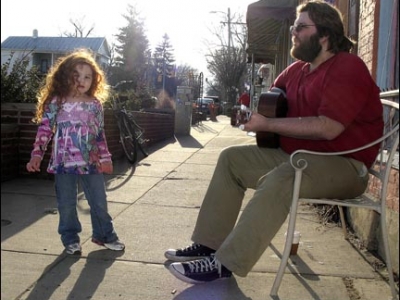Revenue drop leads to levy renewal
- Published: March 10, 2011
On May 3 Yellow Springers will be asked to vote on Issue 1, a renewal of the current Village five-year 8.4 mill property tax levy. The levy, which provides about 25 percent of general fund revenues, will expire at the end of this year.
Approved by voters in November 2006, the levy was intended to shore up Village finances during a time of local business loss. However, due to the unanticipated and still continuing economic downturn, Village Council recently decided that the levy needs to be renewed at its current rate.
The levy renewal allows the Village to continue its current level of services, supporters say.
“That’s why I got involved,” said Barry Reich, co-chair of the Yellow Springs Yes Levy Renewal Committee. “I like what goes on in the village and want to see it continue.”
Other committee members are co-chair Lisa Abel, Megan Bachman, Kate LeVesconte, Len Kramer, Craig Mesure and Ken Huber, along with Village Council members Karen Wintrow and Judith Hempfling.
There are hopeful signs on the horizon in local economic development, most obviously the rebirth of Antioch College. But it will take several years for the college to add a substantial number of jobs to the economy, and also for other economic development initiatives, such as the Center for Business and Education, to come to fruition.
Given the still lagging economy and the stated intention of the Republican-controlled state legislature to eliminate or reduce funding to municipalities, Council recently decided to seek a levy renewal instead of a reduction, which several Council members had originally preferred last year.
Taxes the same
Most homeowners will see no increase in their property taxes if the levy passes, supporters emphasize.
A levy is a tax imposed by voters or governments, and is categorized by its millage, which is $1 of tax for each $1,000 of assessed value of property. Assessed value is 35 percent of appraised value, according to Greene County Auditor-elect David Graham in an interview last week. For the Village 8.4 mill property tax levy, a local homeowner pays about $233 per $100,000 of home valuation.
That amount will not change regardless of whether there’s an increase in the appraised vaue of the home, according to Graham. Rather, if the home’s value increases after a re-appraisal, the tax payers pay the same amount, but the millage is considered to be lower. Because many property values increased during the last re-appraisal in 2008, villagers are actually paying at a rate of 7.611 mills, according to Graham.
“A voted levy is not subject to increases, such as those due to appraisal changes,” he said.
The only villagers who may pay more with a levy renewal are those who make substantial changes to their property, such as adding on a room to their house or building a new structure, Graham said. But small and medium-size renovations will not show up as increased taxes, he said.
As well as the 8.4 mill levy, the Village receives revenues from a 2.3 mill inside, or non-voted, levy that will not be affected by the May vote. The Village receives about $230,000 yearly from this levy, including the state-reimbursed rollback and homestead taxes.
Both Village levies account for about 17 percent of local property taxes; about 53 percent goes to support the schools, 18 percent to Greene County, 7 percent to Miami Township, 4 percent to the Greene County Joint Vocational School and about 1 percent to the Greene County Health District.
Levy for services
The property tax levy goes into the Village general fund, which is the source of revenues for most human services in the village, including road and sidewalk maintenance, police and safety, parks and recreation, the John Bryan community center and maintenance of the Yellow Springs library. The general fund also funds the village mediation program and economic development.
The Village enterprise funds, which fund local utilities — electricity, water, sewer and solid waste — are self sustaining through utility fees, and are not a part of the general fund.
The 8.4 mill property tax levy provides about 25 percent of general fund revenues. In 2010, the village received $760,117 from the levy out of a $2.8 million general fund budget.
Many villagers may not be aware that Yellow Springs provides an abundance of services compared to many small towns, Reich said.
“It’s an impressive list for a village our size,” he said. “These services directly affect the quality of life in the village and are important not only to current residents but to the village’s ability to attract new residents.”
Bryan Center services include meeting rooms, a gym, a dance studio, pottery classes and youth services, a tennis court and basketball courts. Other parks and recreation services include the Gaunt Park pool, which was the only operating pool in Greene County last year, a toddler playground, the skate park, and the maintenance of Ellis Park, with its fishing pond and refuge for wildlife. The Village also maintains the Bill Duncan park, which last year hosted one of several new Village-sponsored comunity gardens, Hilda Rahn Park and the Beatty Hughes Park.
The police department provides, among its many services, the security necessary for local celebrations, such as the Yellow Springs Street Fair, the New Year’s Ball Drop and the Fourth of July fireworks.
The general fund has also provided revenue for the Greenbelt Fund, which seeks to preserve a greenbelt around Yellow Springs through the purchase of conservation easements for local farms. The general fund also includes $50,000 yearly for energy efficiency efforts for Village property.
Economic development activities provided by the general fund include the salary of the part-time economic sustainability coordinator. The general fund also partially funds the salary of the Village Manager Mark Cundiff and Assistant Planner Ed Amrhein, who has overseen Village infrastructure work on the Center for Business and Education, or CBE, which is slated to be ready for occupants next year.
Because the property tax levy provides about one dollar in four of general fund revenues, this level of services could not be maintained without levy revenues, according to Reich.
Revenues decline
The levy renewal is necessary because in recent years the Village has suffered a decline in two significant revenue streams, income tax and investment income, and Village leaders anticipate this year a decline in a third stream, state funding, supporters say.
The total revenues for the 2010 Village general fund budget were about $2.8 million, down from about $3.4 million in 2007, before the recession hit. The 2011 general fund budget anticipates revenues of $2.5 million. Village Manager Mark Cundiff has described the 2011 budget as a cautious one, that estimates revenues on the low side and expenses on the high side.
Village income tax, which provides about 41 percent of general fund revenues, has declined by about $260,000 since its high in 2002. In that year, the Village received $1,510,464 in income tax, which dropped to $1,250,152 in 2006. It increased back up to $1,414,802 in 2008, then dropped to a low of $1,249,773 in 2009. Income tax rose very slightly, to $1,252,158 in 2010, back to about 2006 levels. Village leaders are anticipating a similar amount of income tax revenue this year.
The Village has also seen a significant loss in investment income due to the recession. In 2007, the Village received $160,566 from investments; which dropped to $85,621 in 2008, then to $6,084 in 2009. In 2010, the Village received $2,463 in interest from investments.
Village leaders are also mindful of likely decreases in funding from the state. While the Ohio legislature has not yet voted, a bill to eliminate or reduce the estate tax has already been introduced. Republican leaders have indicated their desire to eliminate or reduce a second source of funding, the local government tax.
If those two state revenue streams were eliminated, the Village would see a further income drop of several hundred thousand dollars compared to the past several years.
In 2008, Yellow Springs received $326,114 in estate taxes, and $262,878 in 2009. In 2010, the Village received $86,772. Because estate taxes are paid after a death and are impossible to predict, the Village does not include estate tax revenues in its regular budget.
However, the local government taxes, the second source of state funding, have remained fairly consistent over the past several years, ranging from a high of $188,028 in 2008 to a low of $151,995 in 2009.
The Yellow Springs News encourages respectful discussion of this article.
You must login to post a comment.
Don't have a login? Register for a free YSNews.com account.

Parkinsons.jpg)













No comments yet for this article.